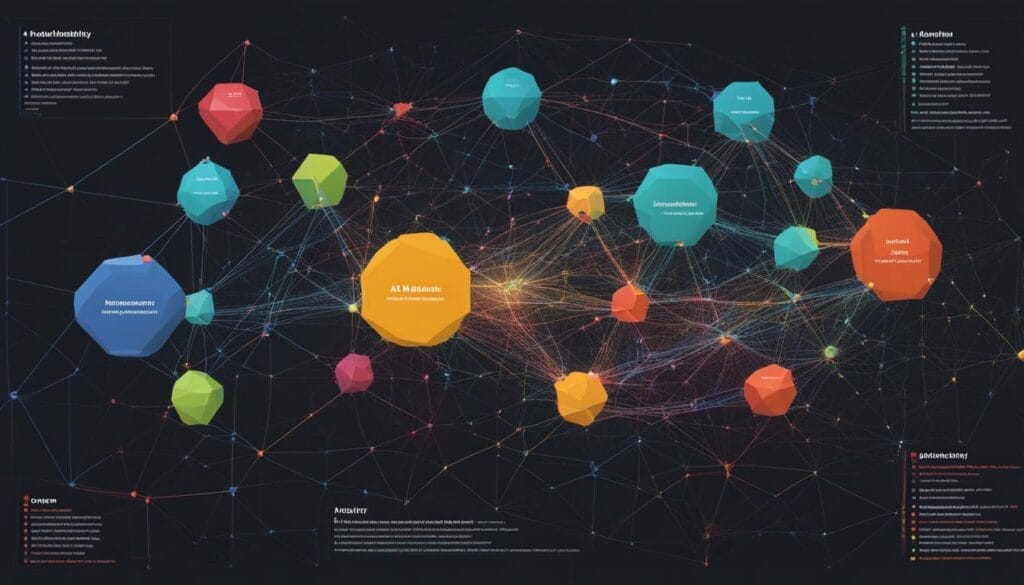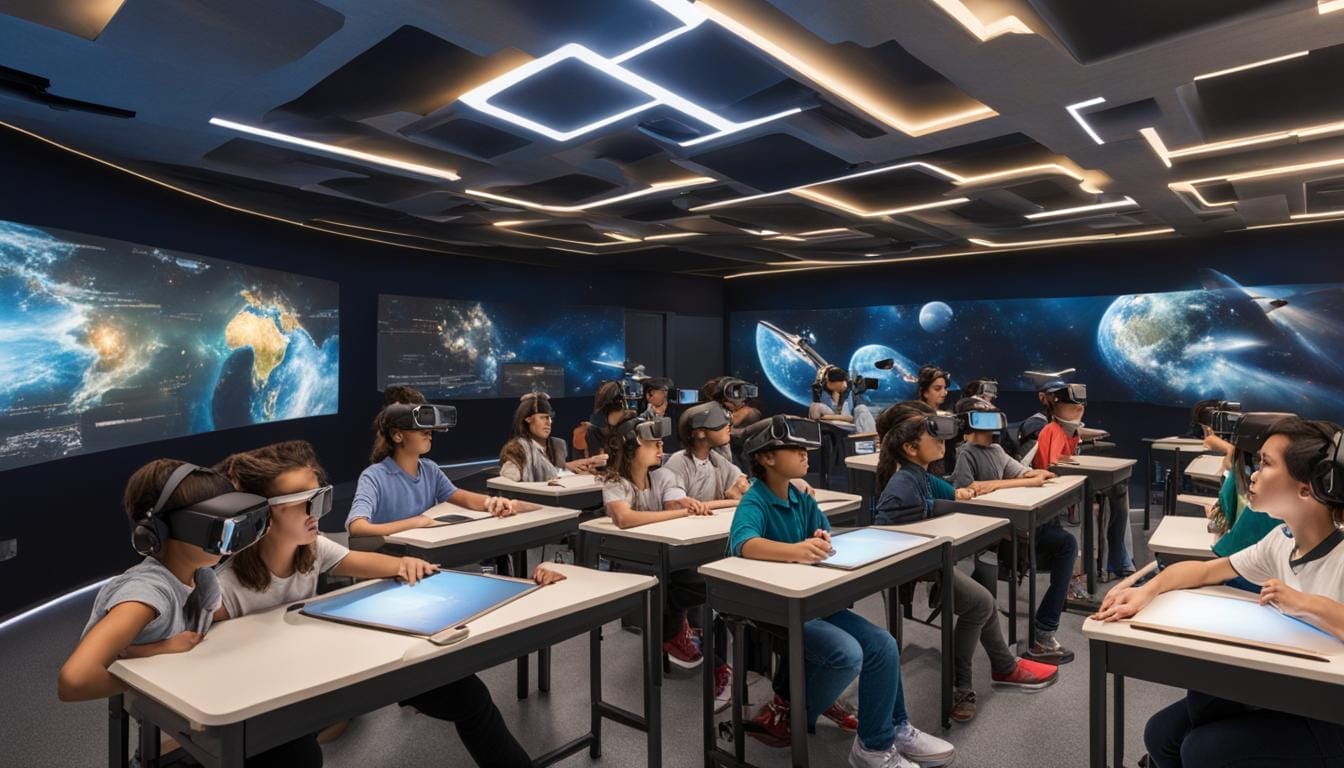As technology continues to advance, its impact on education is becoming increasingly profound. One particular area that is garnering immense attention is AI personalized learning. But what does the future hold for this innovative approach? Will it truly revolutionize the way we educate? And how can artificial intelligence be harnessed to enhance learning outcomes in the classroom?
In this article, we will explore the future trends in AI personalized learning and delve into the exciting possibilities it presents for the future of education. From adaptive learning with AI to the rise of artificial intelligence in education, we will uncover the transformative power of AI in catering to individual student needs and fostering engagement. Join us on this journey as we unlock the potential of AI in shaping the future of learning.
Key Takeaways:
- AI personalized learning is a paradigm shift that tailors educational experiences to individual learners.
- AI integration in education enhances engagement and outcomes for students.
- AI-driven learning analytics provide valuable insights to educators for personalized support and intervention.
- AI-powered educational tools and machine learning algorithms revolutionize traditional teaching methods.
- Supercharged personalized learning paths and truly immersive learning experiences are significant trends in AI for education.
What will the future of education look like with AI personalized learning? How will it revolutionize teaching methods and student engagement? Uncover the transformative power of AI in education in this article.
The Essence of Personalized Learning: Unlocking Individual Potential
Personalized learning is an adaptive and student-centric approach that recognizes individuality and tailors education to specific strengths, weaknesses, and learning styles. It enhances student outcomes by fostering engagement, deeper understanding, and a love for learning.
Traditional approaches often fail to accommodate diverse student needs, making personalized learning with AI an important solution. AI-driven learning analytics provide valuable insights to educators, enabling personalized support and intervention.
With the emergence of AI technology, personalized learning has become more accessible and effective. AI algorithms can analyze vast amounts of data, including student performance, preferences, and learning patterns, to create tailored educational experiences. By leveraging AI-driven learning analytics, educators can gain valuable insights to better understand each student’s learning process and provide customized guidance.
Adaptive learning with AI allows students to learn at their own pace, ensuring that they fully grasp concepts before moving on to new material. This personalized approach promotes deeper understanding and retention of knowledge, which leads to improved academic performance.
The Benefits of Personalized Learning with AI
1. Enhanced Engagement: By tailoring education to individual interests and learning styles, personalized learning with AI keeps students engaged and motivated.
2. Deeper Understanding: With AI-driven adaptive learning, students can spend more time on challenging topics and receive additional support until they master the material.
3. Individualized Support: Learning analytics provide real-time feedback to educators, enabling them to identify struggling students and provide timely intervention and support.
4. Efficient Resource Allocation: AI-powered learning analytics help educators identify the most effective teaching strategies and allocate resources where they are needed most.
“Personalized learning with AI has the potential to revolutionize education by unlocking the full potential of every individual learner.”
To illustrate the impact of personalized learning with AI, here is a table highlighting the benefits:
| Benefits of Personalized Learning with AI | Descriptions |
|---|---|
| Enhanced Engagement | Personalized learning keeps students engaged and motivated by tailoring education to individual interests and learning styles. |
| Deeper Understanding | AI-driven adaptive learning allows students to spend more time on challenging topics, ensuring they fully grasp the material. |
| Individualized Support | Learning analytics provide real-time feedback to educators, enabling timely intervention and support for struggling students. |
| Efficient Resource Allocation | AI-powered learning analytics help educators identify effective teaching strategies and allocate resources where needed most. |
By incorporating AI-driven personalized learning, educators can unlock the individual potential of every student, fostering a love for learning and achieving improved academic outcomes.
The Rise of Artificial Intelligence in Education: Transforming Pedagogy through Innovation
Artificial Intelligence (AI) has emerged as a transformative force in the field of education, revolutionizing traditional teaching methods and creating new opportunities for personalized learning. By harnessing the power of AI technologies, such as machine learning algorithms and data analytics, educators can enhance the learning process and provide tailored guidance to students.
One of the remarkable applications of AI in education is the integration of virtual reality (VR). Virtual reality in education opens up new dimensions of interactive and immersive learning experiences, enabling students to explore different environments and scenarios. Through VR, learners can engage with complex concepts, acquire practical skills, and apply knowledge in simulated real-life situations.
AI-powered educational tools have also made significant strides in transforming pedagogy. Intelligent tutoring systems, for example, leverage AI algorithms to provide personalized guidance and adapt to individual student progress. These tools analyze student performance data in real-time, identifying areas of weakness and tailoring instruction to address specific needs. In this way, AI-powered educational tools enable personalized learning journeys that cater to unique strengths, weaknesses, and learning styles.
Real-world examples of AI-powered educational tools include:
- Knewton: An adaptive learning platform that uses AI algorithms to deliver personalized educational content and recommendations.
- Duolingo: A language-learning platform that employs gamification and AI-driven algorithms to provide interactive, personalized language instruction.
- Cognii: An AI-powered virtual tutor that offers natural language processing and assessment capabilities to provide personalized feedback and engage students in real-time conversations.
The advent of machine learning algorithms in education has further propelled the transformation of pedagogy. These algorithms analyze vast amounts of data to identify patterns, trends, and insights that can inform instructional strategies and address learning gaps. By leveraging machine learning algorithms, educators can optimize the learning experience, improve outcomes, and foster deeper engagement among students.
In conclusion, the rise of artificial intelligence in education brings innovative solutions to the realm of pedagogy. The integration of AI-powered educational tools, virtual reality, and machine learning algorithms has the potential to unlock individual potential, provide personalized guidance, and transform the way students learn and engage with educational content.
AI-Powered Adaptive Learning: Nurturing Personalized Educational Journeys
AI-powered adaptive learning is revolutionizing education by creating a personalized and responsive learning environment. With the ability to tailor educational content, pacing, and assessments based on individual student progress and preferences, adaptive learning goes beyond one-size-fits-all approaches. By leveraging AI algorithms to continuously assess individual progress, adaptive learning platforms can make dynamic adjustments to the learning experience, catering to each student’s unique needs.
The integration of AI in adaptive learning has a profound impact on student outcomes. The personalized and tailored nature of adaptive learning enhances retention, comprehension, and engagement, leading to improved learning outcomes. By addressing individual needs and preferences, adaptive learning ensures that students receive the support and guidance they require to succeed.
One of the key components of AI-powered adaptive learning is the use of AI-powered tutors. These intelligent mentors leverage sophisticated technologies, such as natural language processing and machine learning, to provide personalized guidance and support to students. AI-powered tutors adapt to students’ progress, identifying areas of strengths and weaknesses, and suggesting targeted interventions to drive improvement. This innovation in education facilitates deeper learning and empowers students to achieve their full potential.
The Role of Technology Trends in the Innovation of Education
AI-powered adaptive learning is at the forefront of the innovation in education. By integrating technology trends such as artificial intelligence and machine learning, educational experiences are transformed, offering students dynamic and interactive learning opportunities.
One of the significant trends in adaptive learning is the use of AI-powered virtual reality tools. Virtual reality simulations create immersive learning experiences that enable students to interact with the subject matter in a realistic and engaging way. These experiences promote deeper understanding and retention of concepts, making learning more enjoyable and effective.
Furthermore, the integration of AI-powered technologies in adaptive learning platforms ensures that students receive real-time feedback and personalized recommendations. By leveraging AI-driven learning analytics, educators gain valuable insights into individual students’ progress and can make data-driven decisions to optimize the learning process. With continuous learning analytics, personalized support can be provided to students, ensuring that their educational journeys are nurtured effectively.
Overall, AI-powered adaptive learning showcases the power of innovation in education. By leveraging technology trends and incorporating AI-powered tutors, students can embark on personalized educational journeys that fit their unique needs and goals. This groundbreaking approach fosters engagement, retention, and a passion for learning, revolutionizing the way students acquire knowledge and skills.
Comparing Traditional Learning Approaches with AI-Powered Adaptive Learning
| Traditional Learning Approach | AI-Powered Adaptive Learning |
|---|---|
| One-size-fits-all approach | Tailored and personalized learning experiences |
| Limited room for individual progress tracking | Real-time assessment and dynamic adjustments |
| Generic learning materials | Customized content based on individual needs |
| Static learning environment | Responsive and interactive learning environment |
| Less student engagement | Enhanced engagement and motivation |
Supercharged Personalized Learning Paths: Unlocking Individual Potential

In the ever-evolving landscape of education, personalized learning has emerged as a transformative approach to cater to the unique needs of learners. With the advent of generative AI, personalized learning paths have been supercharged to unlock individual potential and revolutionize the way we acquire knowledge.
By harnessing the power of AI algorithms, personalized learning paths are crafted based on individual learning histories, preferences, and performance metrics. This analysis allows educators to create bespoke educational experiences that cater specifically to the strengths, weaknesses, and learning styles of each learner.
With supercharged personalized learning paths, engagement is enhanced as students find themselves captivated by educational experiences tailored to their needs. By accelerating skill mastery, both students and educators experience a more efficient and effective learning journey.
Imagine a classroom where students receive personalized support every step of the way, allowing them to reach their full potential. Supercharged personalized learning paths offer just that – a tailored approach that empowers students to thrive in their educational pursuits.
“Education is not the filling of a bucket, but the lighting of a fire.”
Personalized Support for Every Learner
Supercharged personalized learning paths encompass various strategies and methodologies to provide students with the support they need. Some key elements include:
- Adaptive assessments to identify individual learning needs
- Customized content and resources
- Real-time feedback and progress tracking
- Interactive and engaging learning experiences
By leveraging machine learning in the classroom, educators can create a dynamic and responsive learning environment that meets students where they are and helps them succeed.
The Power of Data-Driven Personalization
Central to supercharged personalized learning paths is the analysis of data. By collecting and analyzing data on individual learners, educators can gain valuable insights into each student’s strengths, weaknesses, and progress. This data-driven approach allows for continuous refinement and improvement of the personalized learning experience.
With the help of AI algorithms, educators can identify patterns and trends in student performance, allowing them to make informed decisions about instructional strategies and interventions. This data-driven personalization ensures that every student receives the targeted support they need to excel.
| Benefits of Supercharged Personalized Learning Paths | Challenges Addressed |
|---|---|
| Enhanced engagement and motivation | Traditional one-size-fits-all approaches |
| Accelerated skill mastery | Addressing diverse learning styles and preferences |
| Improved learning outcomes | Individualized support for each learner |
| Targeted interventions and support | Addressing gaps in knowledge and understanding |
Truly Immersive Learning Experiences: Engaging Students in Virtual Realities
Generative AI is driving the development of truly immersive learning experiences. Through the use of virtual reality in education and personalized learning with AI, students are now able to engage in interactive and dynamic simulations, providing an unprecedented hands-on learning experience in a risk-free environment.
Immersive learning experiences offer numerous benefits for students. By creating an environment that closely resembles real-life scenarios, students can actively participate and apply their knowledge. This active engagement enhances retention and comprehension, making the learning process enjoyable and practical.
With AI-powered personalization, the content delivered within virtual realities can be tailored to match the learner’s proficiency level and learning pace. This ensures that students receive the right level of challenge and support, enabling them to progress at their own speed.
“Virtual reality technology allows us to transcend the limitations of traditional classrooms and textbooks, providing students with an immersive and transformative learning experience.” – Dr. Sarah Johnson, Education Expert
By incorporating technology trends such as virtual reality and personalized learning with AI, educators can create a dynamic and engaging learning environment that stimulates students’ curiosity, critical thinking, and problem-solving skills. It bridges the gap between theory and practice, preparing them for future careers that increasingly rely on technological proficiency.
Benefits of Immersive Learning Experiences
| Benefits | Description |
|---|---|
| Enhanced Retention | Students are more likely to remember information when they experience it in a realistic and immersive setting. |
| Improved Comprehension | Interactive simulations help students develop a deeper understanding of complex concepts by allowing them to explore and manipulate data. |
| Active Engagement | Immersive learning experiences motivate students to actively participate, fostering curiosity, collaboration, and creativity. |
| Real-World Application | By experiencing scenarios in a virtual environment, students can practice skills and knowledge in a safe and controlled setting. |
As virtual reality in education continues to evolve, the potential for transformative learning experiences becomes even greater. It offers new avenues for exploration, discovery, and innovation, enabling students to develop the skills and knowledge they need for the future.
Continuous Learning Analytics: Real-Time Insights for Enhanced Learning

Continuous learning analytics is transforming the way we approach learning and development by integrating AI-driven learning analytics into educational processes. By harnessing the power of AI algorithms, continuous learning analytics provides real-time insights into individual and collective learning patterns, enabling educators to make data-driven decisions for enhanced learning outcomes.
With AI-driven learning analytics, educators can analyze student data in real-time, gaining valuable insights into areas of improvement and addressing specific challenges in a timely manner. This real-time feedback and assessment allow for personalized support and intervention, ensuring that learners receive the necessary guidance to overcome obstacles and stay engaged in their educational journeys.
“Continuous learning analytics enables educators to identify areas of improvement and address learner stress or disengagement in real-time, leading to enhanced learning outcomes.”
By leveraging AI technology, continuous learning analytics provides a comprehensive understanding of learners’ progress, identifying their strengths and weaknesses. This valuable information allows educators to tailor instruction and learning experiences to meet individual learner needs, fostering a more personalized and effective approach to education.
Furthermore, continuous learning analytics contributes to the efficacy of training programs by providing educators with valuable insights into the effectiveness of their curriculum and instructional strategies. By gaining real-time visibility into the impact of their teaching methods, educators can make data-informed adjustments to optimize the learning experience and ensure better outcomes for their students.
Through the integration of AI-driven learning analytics, technology trends that prioritize data-driven decision-making and personalized education are becoming increasingly prevalent in the field of learning and development. By harnessing the power of AI, educators can unlock the full potential of their students and provide them with the support and guidance needed to succeed in their educational endeavors.
Real-Time Insights through AI-Driven Learning Analytics:
- Identifying areas of improvement and addressing learner stress or disengagement in real-time.
- Personalizing instruction and learning experiences based on individual learner needs.
- Optimizing training programs through data-driven decision-making.
- Unlocking the full potential of students through personalized support and guidance.
With continuous learning analytics, the possibilities for enhanced learning experiences and improved outcomes are limitless.
Stay ahead of the technology trends:
Technology trends in education continue to evolve, and AI-driven learning analytics stands at the forefront of innovation. By staying updated and embracing these trends, educators and institutions can provide their students with the best possible learning experiences in an ever-changing digital landscape.
Stay tuned for the next section as we explore another exciting aspect of AI integration in education: dynamic content development.
Dynamic Content Development: Customization and Efficiency in Learning Materials
Generative AI is revolutionizing content development in learning and development. With the help of AI-powered educational tools and machine learning algorithms in education, content generation has become more efficient, customizable, and adaptable to individual needs. Algorithms analyze vast datasets to generate learning materials that cater to diverse learning styles and preferences.
AI-powered content recommendation engines further enhance the learning experience by providing personalized materials. By leveraging technology trends, such as AI-powered educational tools and machine learning algorithms in education, content can be tailored to match the unique requirements of each learner. This optimization ensures increased engagement and better learning outcomes.
One practical application of dynamic content development is the ability to generate interactive exercises and quizzes that adapt to the learner’s progress. This personalized approach keeps learners motivated and challenged, leading to a deeper understanding of the subject matter.
Moreover, AI-driven content development allows for real-time updates and customization. As technology trends evolve, educational content can easily be modified to reflect the most recent information or advancements in the field. This ensures that learners have access to the most up-to-date and relevant materials.
| Benefits of Dynamic Content Development | Examples |
|---|---|
| Customization | Adaptive learning paths tailored to individual needs and preferences |
| Efficiency | Automated content generation and updating processes |
| Adaptability | Real-time adjustments to learning materials based on learner performance |
Dynamic content development powered by AI not only provides customization and efficiency but also improves the overall quality and relevance of learning resources. As technology trends continue to shape the future of education, embracing AI-powered tools and leveraging machine learning algorithms in education will be essential for educational institutions to stay ahead.
Conclusion
The integration of artificial intelligence (AI) in personalized learning is driving future trends in education. By harnessing the power of AI, educators can unlock the individual potential of learners and foster engagement and understanding in the classroom.
AI-powered adaptive learning, immersive experiences, continuous learning analytics, and dynamic content development are reshaping the way learners acquire and apply knowledge. Adaptive learning tailors educational content and assessments to individual student progress and preferences, enhancing retention, comprehension, and engagement. Immersive experiences, such as virtual reality, provide hands-on learning in a risk-free environment, making education enjoyable and practical.
Continuous learning analytics, powered by AI, provide real-time insights into individual and collective learning patterns, enabling educators to make data-driven decisions and optimize the efficacy of training programs. Dynamic content development, facilitated by AI, offers customization, efficiency, and adaptability, generating personalized learning materials that cater to diverse learning styles and preferences.
While the future of AI in education holds immense promise, ethical considerations, data privacy, and equitable access to personalized learning opportunities remain important areas of focus. With the right AI expertise and the implementation of AI-powered solutions, education can be transformed, empowering learners and preparing them for the challenges and opportunities of the future.
FAQ
What is personalized learning?
Personalized learning is an adaptive and student-centric approach that tailors education to individual strengths, weaknesses, and learning styles.
How does AI integration enhance personalized learning?
AI integration in education allows for adaptive and personalized learning experiences, enhancing engagement and outcomes for students.
What are AI-driven learning analytics?
AI-driven learning analytics provide valuable insights to educators, enabling personalized support and intervention based on individual student data.
How does AI revolutionize traditional teaching methods?
AI technologies, such as virtual reality and machine learning algorithms, revolutionize traditional teaching methods by providing interactive and dynamic simulations.
What are some AI-powered educational tools?
Examples of AI-powered educational tools include Knewton, Duolingo, and Cognii, which provide personalized guidance and adapt to students’ progress.
How does AI-powered adaptive learning work?
AI-powered adaptive learning creates a personalized and responsive learning environment by tailoring educational content, pacing, and assessments based on individual student progress and preferences.
How do immersive learning experiences enhance education?
Immersive learning experiences, powered by AI and virtual reality, enhance education by providing hands-on learning in a risk-free environment, improving retention and comprehension.
What is continuous learning analytics?
Continuous learning analytics integrates AI to analyze student data in real-time, providing insights into individual and collective learning patterns for improved learning outcomes.
How does AI-powered content development improve learning resources?
AI-powered content generation analyzes vast datasets to generate customized and adapted learning resources, enhancing relevance and quality.
How does AI integration shape the future of education?
AI integration in personalized learning unlocks individual potential, fosters engagement and understanding, and contributes to innovation in education.





